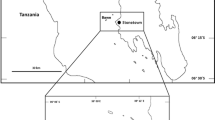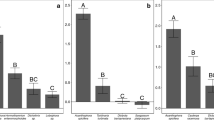Abstract
Chondrilla nucula is a common Caribbean demosponge that grows in a range of habitats, from coral reefs to mangrove swamps. On reefs, C. nucula grows as a thinly encrusting sheet, while in mangrove habitats it surrounds submerged mangrove roots as fleshy, lobate clumps. Previous feeding experiments using predatory reef fish revealed a high degree of variability in the chemical defenses of C. nucula. The present study was undertaken to determine whether a relationship exists between habitat, growth form, and chemical defense of C. nucula. Both laboratory and field feeding-assays of crude extracts confirmed that C. nucula possesses a chemical defense with high intercolony variability, but there was no significant variation in feeding deterrency between reef and mangrove habitats at either geographic location (Bahamas and Florida). Extracts of C. nucula collected during September and October 1994 from the Bahamas were significantly more deterrent than those collected during August 1993, May 1994, and May 1995 from Florida, and extracts of these spring and summer Florida collections were more deterrent than extracts of C. nucula collected in December 1994 and February 1995 in the same locations. There was no evidence that deterrent compounds were concentrated in the surface tissues of the sponge, or that chemical defense could be induced by simulated predation. Laboratory and field assays of the fractionated crude extract revealed that feeding deterrency was confined to the most polar metabolites in the extract. Field transplants were used to determine whether predation influenced the growth form of C. nucula. Uncaged sponges transplanted from the mangrove to the reef were readily consumed by spongivorous reef fishes. Lobate mangrove sponges became thinner after being caged on the reef for 3 mo, but encrusting reef sponges did not become thicker after being caged in the mangroves for the same period of time. Reef sponges that were caged for 3 to 15 mo thickened by only a small amount (<1 mm) compared to uncaged and open-caged (i.e. in cages lacking tops) sponges. Simulated bite marks on both reef and mangrove sponges were repaired at a rapid rate (0.8 to 1.6 mm d−1). Fish predation has an important impact on the distribution and abundance of C. nucula, but the thin growth form common to reef environments may be more the result of hydrodynamics than of grazing by spongivorous fishes.
Similar content being viewed by others
Author information
Authors and Affiliations
Additional information
Received: 6 October 1997 / Accepted: 19 March 1998
Rights and permissions
About this article
Cite this article
Swearingen III, D., Pawlik, J. Variability in the chemical defense of the sponge Chondrilla nucula against predatory reef fishes. Marine Biology 131, 619–627 (1998). https://doi.org/10.1007/s002270050354
Issue Date:
DOI: https://doi.org/10.1007/s002270050354




